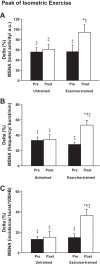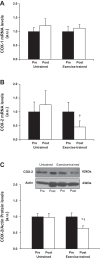Molecular basis for the improvement in muscle metaboreflex and mechanoreflex control in exercise-trained humans with chronic heart failure
- PMID: 25305179
- PMCID: PMC4255006
- DOI: 10.1152/ajpheart.00136.2014
Molecular basis for the improvement in muscle metaboreflex and mechanoreflex control in exercise-trained humans with chronic heart failure
Abstract
Previous studies have demonstrated that muscle mechanoreflex and metaboreflex controls are altered in heart failure (HF), which seems to be due to changes in cyclooxygenase (COX) pathway and changes in receptors on afferent neurons, including transient receptor potential vanilloid type-1 (TRPV1) and cannabinoid receptor type-1 (CB1). The purpose of the present study was to test the hypotheses: 1) exercise training (ET) alters the muscle metaboreflex and mechanoreflex control of muscle sympathetic nerve activity (MSNA) in HF patients. 2) The alteration in metaboreflex control is accompanied by increased expression of TRPV1 and CB1 receptors in skeletal muscle. 3) The alteration in mechanoreflex control is accompanied by COX-2 pathway in skeletal muscle. Thirty-four consecutive HF patients with ejection fractions <40% were randomized to untrained (n = 17; 54 ± 2 yr) or exercise-trained (n = 17; 56 ± 2 yr) groups. MSNA was recorded by microneurography. Mechanoreceptors were activated by passive exercise and metaboreceptors by postexercise circulatory arrest (PECA). COX-2 pathway, TRPV1, and CB1 receptors were measured in muscle biopsies. Following ET, resting MSNA was decreased compared with untrained group. During PECA (metaboreflex), MSNA responses were increased, which was accompanied by the expression of TRPV1 and CB1 receptors. During passive exercise (mechanoreflex), MSNA responses were decreased, which was accompanied by decreased expression of COX-2, prostaglandin-E2 receptor-4, and thromboxane-A2 receptor and by decreased in muscle inflammation, as indicated by increased miRNA-146 levels and the stable NF-κB/IκB-α ratio. In conclusion, ET alters muscle metaboreflex and mechanoreflex control of MSNA in HF patients. This alteration with ET is accompanied by alteration in TRPV1 and CB1 expression and COX-2 pathway and inflammation in skeletal muscle.
Keywords: exercise training; heart failure; mechanoreflex; metaboreflex; muscle sympathetic nervous system.
Copyright © 2014 the American Physiological Society.
Figures







References
-
- Antunes-Correa LM, Kanamura BY, Melo RC, Nobre TS, Ueno LM, Franco FG, Roveda F, Braga AM, Rondon MU, Brum PC, Barretto AC, Middlekauff HR, Negrao CE. Exercise training improves neurovascular control and functional capacity in heart failure patients regardless of age. Eur J Prev Cardiol 19: 822–829, 2012. - PubMed
-
- Azevedo ER, Kubo T, Mak S, Al-Hesayen A, Schofield A, Allan R, Kelly S, Newton GE, Floras JS, Parker JD. Nonselective vs. selective beta-adrenergic receptor blockade in congestive heart failure: differential effects on sympathetic activity. Circulation 104: 2194–2199, 2001. - PubMed
-
- Barretto AC, Santos AC, Munhoz R, Rondon MU, Franco FG, Trombetta IC, Roveda F, de Matos LN, Braga AM, Middlekauff HR, Negrao CE. Increased muscle sympathetic nerve activity predicts mortality in heart failure patients. Int J Cardiol 135: 302–307, 2009. - PubMed
-
- Batista ML, Jr, Rosa JC, Lopes RD, Lira FS, Martins E, Jr, Yamashita AS, Brum PC, Lancha AH, Jr, Lopes AC, Seelaender M. Exercise training changes IL-10/TNF-alpha ratio in the skeletal muscle of post-MI rats. Cytokine 49: 102–108, 2010. - PubMed
Publication types
MeSH terms
Substances
LinkOut - more resources
Full Text Sources
Other Literature Sources
Medical
Research Materials
Miscellaneous

